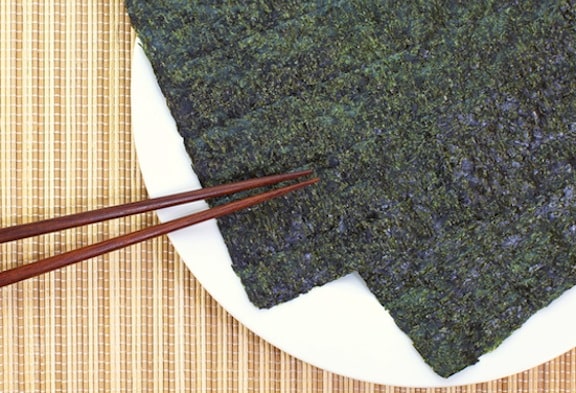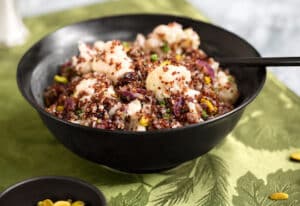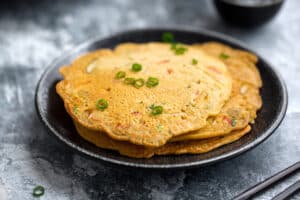Sea vegetables are getting more attention now that sushi is so popular. For thousands of years, cooks on every continent have made flavorful meals from sea vegetables—soup, stews, garnishes, condiments, and even desserts. Sea vegetables are rich in minerals and vitamins and low in calories. You may also find that eating sea vegetables satisfies your need for salt. (Rinse sea vegetables before cooking them to reduce their sodium content.)
Most people eat Irish moss, a sea vegetable without even knowing it. Irish moss is boiled down to make carrageenan, an important stabilizer in ice cream, puddings, pies, fruit syrups, cheeses, and instant soups. You can use it at home to thicken vegetable dishes or to gel desserts. Irish moss is high in vitamin A, iodine, and trace minerals. Gelatins made with Irish moss are soothing remedies for ulcers. Irish moss also relieves respiratory ailments.
In macrobiotic cooking, sea vegetables are considered tasty preventive medicine for high blood pressure, arteriosclerosis, rheumatism, allergies, arthritis, and nervous disorders. Because they contain vitamin B12 and iron, sea vegetables are good blood builders.
Sea vegetables contain trace elements' barium, boron, chromium, lithium, nickel, silicon, silver, strontium, titanium, vanadium and zinc, which are sometimes lacking in our soil and vegetables.
These wild, wonderful foods are harvested from rocky surfaces deep in the ocean at appropriate times of the year. Superior quality sea vegetables are wild crafted from pristine waters. Then they are sun dried, packaged and stored. They can keep for years in a cool, dry, dark, place.
Here are three of Leslie Cerier's recipes for Sea Vegetables.
POPULAR SEA VEGETABLES
Agar agar can make jams, jellied salads, aspics, kanten (gelatin), and non dairy custard. Simmer 1 tablespoon agar agar flakes per cup of liquid into your dessert stock such as juice, add spices and fruits, chill and serve. Unlike other sea vegetables, agar agar is odorless.
Nori (sea lettuce) is a delicate purplish-black sheet that turns green when lightly toasted. Wrap it around rice, cooked and raw vegetables, noodles, tofu, seitan, tempeh, or fish to make sushi, a great lunch, appetizer, or traveling snack. Toasted and crumbled nori is a tasty garnish and condiment. Of all the seaweed's, it is the highest in protein, iron, vitamins A and B2, and is the only one without sodium.
Kelp and ocean ribbons are quicker cooking, sweeter, delicate, thinner, leafy varieties of kombu. Digitata's (horsetail kelp) tough texture softens with longer cooking. Kelp and kombu isolate radioactive substances in the body for elimination. They cleanse the circulatory system, reduce hypertension and high blood pressure.
Kombu looks like a narrow, olive-brown lasagna noodle. It enhances flavors and is a tenderizer, too. Sodium glutamate is extracted and concentrated by long simmering of kombu and then added to foods to enhance their natural flavors. Monosodium glutamate (MSG) is a synthetic version. To tenderize and to blend kombu into other foods, cook it a long time. It reduces flatulence when cooked with dried beans. You can use it in soup stocks, stuffing's, fish and vegetable stews, or pickle or deep fry it. Kombu is high in iron, calcium, and iodine.
Alaria, see Wakame.
Arame has a mild, sweet flavor. It looks like black threads. To cook, rinse and soak it for 5 minutes. Add it to soup, stews, sautés, or marinate it for salads.
Dulse is a soft, leafy, deep red, purple, and brown sea vegetable, perfect for a snack. It melts in your mouth. Kids love it. Add it to oatmeal, soup, stews, bean dishes, or rinse it and add it to a salad in place of spinach. Dulse is high in potassium, phosphorus, iron, protein, vitamin C, and fat (3.2 grams per 100, high in fat compared to the other sea vegetables), but the fat in combination with protein, yields a nutty flavor.
Hiziki, an erect black sea grass, is popular as a side, or in soups, salads, and sandwiches. Hiziki and arame are good camping foods. Soak them for 5 minutes and eat them without cooking. Hiziki has the most calcium of all the sea vegetables. It is very rich in iron and vitamin A, too. Oriental folk medicine recommends it for pregnant women.
Sea Palm, the fettucini of sea vegetables, is dark green, versatile, and sweet. With all its salt water minerals and trace elements intact, it is my children's favorite in soup. It is also delicious in salads, sautés, stews, and noodle dishes.
Wakame is a dark-green sea leaf. It is the seaweed highest in alginic acid, which cleanses heavy metals such as lead, mercury, and cadmium from the intestines. Fermented foods, such as miso, facilitate this function. Use it in miso wakame soup, in salads, with fresh or marinated vegetables, or in tender-root vegetable and bean dishes. Roast it lightly. Add roasted sesame seeds. Grind the two together in a suribachi or food processor and use it as table salt. Wakame is high in calcium and B12. Alaria is similar to wakame. Its mild flavor is delicious when simmered for a long time in stews and soups. Before drying, some wakame is blanched in boiling water, but alaria is not.
Leslie Cerier is a gourmet organic caterer, cooking instructor, nutritional expert, advocate for sustainable agriculture, and award-winning photographer. She is the author of Gluten-Free Recipes for the Conscious Cook,Going Wild in the Kitchen, The Quick and Easy Organic Gourmet* and coauthor of Sea Vegetable Celebration.* A pioneer and national authority on wheat-free baking, cooking with wild foods and whole grains, she has developed recipes for organic food companies and published dozens of articles on vegetarian cooking, nutrition, and organic lifestyle. You can visit her website at LeslieCerier.com.
- For lots more features on healthy lifestyle, please explore VegKitchen’s Healthy Vegan Kitchen page.
- Here are more of VegKitchen's Natural Food Guides.
*This post contains affiliate links. If the product is purchased by linking through this review, VegKitchen receives a modest commission, which helps maintain our site and helps it to continue growing!







thenoveilst says
Wonderful tips.